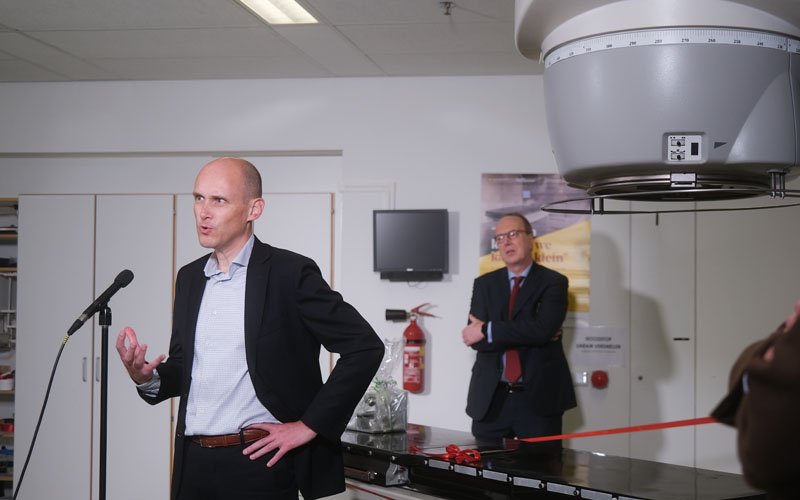New linear accelerator for veterinary medicine faculty
Improving cancer treatment for animals
The faculty of Veterinary Medicine recently installed a new linear accelerator (linac). In the Netherlands, the Faculty of Veterinary Medicine is the only place where animals with cancer can be treated with a linear accelerator. The installation of the linac was made possible and supplied in part by Elekta, an innovative leader in the field of radiotherapeutic medicine, in collaboration with UMC Utrecht and social partners. “This linac demonstrates our commitment to make quality radiation therapy accessible to all, including our pets, which are often like family members. Furthermore, this way we support innovative research that not only impacts animal oncology but potentially also human oncology,” says Tom van den Boogaart, Managing Director of Elekta.
Fewer radiation moments
Cancer is the number 1 cause of death in humans and animals. For some forms of cancer, radiation with a linear accelerator is the only treatment option. In both humans and animals. Standard treatment with radiation often means that as many as 35 daily treatments are required. As a rule, irradiation is less frequent in animals. This is mainly because any treatment must take place under sedation. Over the years, it has become apparent that 15-17 radiation treatments are sufficient for standard treatment. With this approach, an effective treatment with limited side effects and a minimum number of narcoses is achieved.
But radiation treatments remain stressful for the patient. In human radiotherapy, work is now being carried out on less intensive treatment processes with a lower treatment frequency, but at the same time a higher dose. Of course, administering such a dose requires great precision.
For animals, the impact of radiation is greater, because, as indicated earlier, sedation is required. That is why the veterinarian researchers of the Faculty of Veterinary Medicine want to move towards less and less radiation moments. With the arrival of the new accelerator, brain tumors can be switched from the usual 16 treatments to just 10 treatments and hopefully even less in the long term. With the arrival of the new accelerator, veterinarian researchers can start with this and continue to work on optimizing the existing radiation routes.

Unique position
Robbert Tersteeg, head of Radiotherapy UMC Utrecht explains why the collaboration with Veterinary Medicine is so important. “The radiotherapy department of UMC Utrecht is a world leader in innovative developments and pioneering cancer treatments. The fact that we are located next to the Faculty of Veterinary Medicine, the only place in the Netherlands where medical care and research for companion animals takes place, offers a unique opportunity to help, strengthen and work together. Doing research from multiple angles offers a broader view of your field and provides a lot of knowledge and creativity. Besides the differences, there are also many similarities between humans and animals with cancer. It is great when treatments are eventually developed that are an improvement for both humans and animals. ”
Wouter Dhert, Dean, Faculty of Veterinary Medicine: “We are happy and grateful for the fantastic support and commitment of our partners, without whom this accelerator would not have been possible. The purchase of a new accelerator entails considerable costs that the faculty cannot afford itself. Unlike in humane hospitals, animal owners largely pay the costs of a treatment themselves and the faculty, as an independent academic institute, has no profit motive. But at the same time, we want to be able to provide our patients with the best possible innovative veterinary care, as well as contribute to groundbreaking translational research. This is now possible.”
The purchase of the linear accelerator has been made possible thanks to Elekta, UMC Utrecht, Leiden UMC, Stichting Het Waardige Dier, Stichting Abri voor Dieren, Stichting D.O.G. and Stichting DierenLot.
Curious about the construction of the linear accelerator? Then take a look at this video: https://www.youtube.com/watch?v=MotA3pW70AA.

